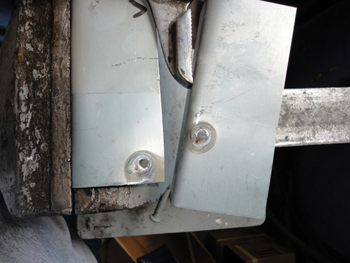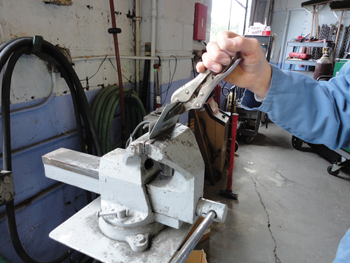 When
When
I sat down to write this article, I tried to think of a clever opening
paragraph. When I couldn’t come up with anything, I wasn’t too upset
because I realized being clever wasn’t important – but doing quality
welds is. Asking “How are your shop’s welds?” is a serious question with
serious ramifications. It’s also a controversial subject.
Some
may be offended, others may be mortified. Still others may learn. The
questions are familiar. For technicians, they are: How good are your
welds? How do you know? For managers, the questions are: Do you know if a
weld is good or not? How do you know?
Wow and Not-So-Wow
Before
I go any further, let me preface this article by saying that as I
travel this country and see many types of shops from all different
areas, I’m tickled at how much pride many technicians take in their
work. The quality in this industry keeps amazing me. In the last year,
I’ve been seriously wowed on my trips. But I’ve also seen shops that
didn’t wow me.
I started asking all the shops, “What makes you
run?” The “wow” shops all had the same answer: investing in employees.
Not just training, but including them on shop issues. Creating a team,
not just employees. Helping them see the big issues and understand why
things need to be done. Accountability was a common word used. The
“not-so-wow” shops had excuse after excuse, blaming someone else.
Accountability struck a chord in my head.
Types
One
of the most common and important procedures the collision industry does
is weld. We do various types of welds, including Gas Metal Arc Welding
(GMAW) in the form of Metal Active Gas Welding (MAG) with 75 percent
argon/25 percent CO2 (or a similar combination) and Metal Inert Gas
(MIG) with 100 percent argon. This includes aluminum and silicon bronze
welding. Many shops have also invested in a Squeeze Type Resistance Spot
Welder (STRSW). No matter what type of welding or machine you have in
your shop, the question to all technicians and managers is: How good are
your welds? When was the last time you checked?
The I-CAR
welding test (WCS03) showed me some interesting things, including that
many technicians are great welders. It also showed that many technicians
don’t know how to set up a welder. Do yours? Do you?
Ask most
technicians who took the I-CAR WCS03 test and they’ll tell you they
learned a lot about welds and machines. Most comment that the test
improved their welding and understanding of the importance each weld has
to a vehicle structure. Training for many like myself was a long time
ago, so many basics have been forgotten. I don’t know of any profession
where, after a long time, a refresher course isn’t needed.
Good vs. Bad
What makes a good weld? Without getting too technical, it takes:
- A person to weld. (This includes the ability to see where they’re welding).
- A welder that is correct and set correctly for the material to weld.
- Training of the operator to use the welder.
If
any of these three categories aren’t working correctly, a bad weld will
be made or won’t be depending on how you look at it. So let’s break
some basics down.
Technicians
- Do they have the correct safety equipment? Protective clothing? Respirators? Do they use them?
- Vision.
Do they wear glasses? If a technician needs to put on glasses to read
instructions or car labels, glasses or cheaters might need to be one of
their required tools. You need to see the weld to make a quality weld. - A
welding visor seems to be an option for many technicians. “Look away”
welders are abundant in our industry. If you hear or see a welder, check
to see if they’re wearing a visor. There seem to be a lot of hand
shielders, too, or people who can see the weld just by holding up their
hands in front of the arc. However, this will burn out your eyes
quickly. - Respirator. Welding galvanized steels and other metals
may produce fumes that contain heavy metals, which can lead to serious
health issues. Many shops I see forgo the respirators and instead have
fans blowing on technicians. The problem with this is that the shielding
gas you need to make a quality weld also gets blown away.
 Welders
Welders
- Proper
power supply. Do you have extension cords attached? Are you supposed
to? Does your shop have enough power at that outlet? If four other
people are operating equipment on that same circuit, who might not be
getting correct power? - Properly maintained machine. Are the tips
correct and not damaged? Is the nozzle in good shape and correct for
the application? Are the rollers for the wire clean and correct?
Improperly maintained machines are a big reason for failed welds and
technicians struggling to weld. This has a huge impact on production. - Proper
wire. Is the tensile strength correct and/or the alloy for application
according to the vehicle manufacturer? Is the liner clean? Is the helix
correct? Is the wire diameter correct? - Settings. Are the settings for the material correct? Check inside the wire panel for directions on this.
- Gas and gas settings. What type of gas? Are you supposed to be MIG or MAG welding? What PSI should the gas be?
Training
- Does
the technician know how to set up the machine? This sounds like a “duh”
statement, but you would be surprised at how many don’t know how to do
this. They just keep making adjustments until it sounds good. - Do they understand the parameters of the adjustments? Just because it sounds good doesn’t mean they’re making good welds.
- Do they know how to prep metal for welding? Do they understand thickness of material? Corrosion protection? Contamination?
- What type of weld do they need to make? Continuous plug stitch or skip?
- Depending on the type of welding required for specific metals (wire or weld), do they use the push or pull technique?
- Do they have or use a shunt during STRSW or spot welding?
- Do they know when MIG brazing is required?
I
could ask many more questions in each category, but I think you get the
idea. If you’re a shop owner or manager and your answer to these
questions is yes for every technician who welds in your shop, awesome!
Now, just one last item needs to be done: show me. I don’t want to see
how pretty the weld is; I want to see how strong it is. A big wake-up
call is a video in the new I-CAR course (FFR01) that shows a weld being
done on a frame. One welder was properly powered, and one wasn’t. The
welder that was set correctly and had the proper amperage to weld the
frame did great. The welder that was underpowered made a good-looking
weld, but the weld failed miserably. The lesson here is that looks can
be deceiving.
Test Welds
Because looks can be
deceiving, I’m a big fan of test welds prior to welding on a vehicle. A
test weld is the exact weld being made on the same thickness and
position of material, preferably damaged metal from the vehicle that’s
going to be discarded. Following the test weld, a destructive test done
in a vise will properly indicate if you’re set to weld the vehicle.
Another
reason to do a test weld is that many welders don’t make a good quality
weld cold. Electronics, moving parts, triggers and relays need to warm
up for the best results. If there’s a problem with the machine, welding
on the vehicle being repaired is not the place to find out.
Too many
times, technicians get out the welder and set up and start welding on a
vehicle. The person who used the welder before could have made the
settings way off, or the tip could be garbage. It may take a weld or two
or four or five to figure it out. The point is, how many practice welds
does a vehicle manufacturer allow to be done on a vehicle? How many of
these practice welds could fail? How many could cause corrosion? How bad
could this get? How quickly can a shop’s reputation be destroyed by one
technician in a shop? This is why we ask for test welds. And by asking
for test welds, all technicians welding in the shop – not just one
technician or a role rep – know what’s expected. Back to accountability.
Remember, it isn’t just your reputation on the line. Your customers are
betting their lives on these welds.
Eliminating the Bad
A
test weld gives you the benefit of knowing that all your technicians
know what they are and what they need to do. The test weld gets the bad
out of the system. Many first welds or cold welds fail destructive
testing. Why would any shop or technician want this weld anywhere on a
vehicle? The test weld gives you, as a manager and owner, the confidence
that your technicians know how to test and judge their own work, too.
The little bit of time preparing and testing can help you avoid or
reduce many comebacks for quality control or, in worst case scenarios,
issues in a crash. This will also show that the shop followed the repair
procedures required by vehicle manufacturers. During re-inspections,
many times it’s the welds that cost a shop.
When a weld is made,
follow all dressing and corrosion protection procedures to maintain its
longevity. You can be an awesome welder but blow it all out the door by
not following corrosion control procedures.
Maintenance is a
major problem for any welding machine. A shop can spend a serious amount
of money for the best welder out there, but if it’s not maintained, it
becomes a drain on time and resources. Keep a regimen for all to
maintain and clean your machines. Simply put, maintain what makes you
money!
Don’t Assume
We’ve all heard the parable about
assuming anything. We assume all techs know how to weld. We also assume
that they know how to weld correctly, and that management knows the
difference between a good weld and a weld that does not pass the test.
Do you?
Mitch Becker is a technical instructor for ABRA Auto Body & Glass. Contact him at (763) 585-6411 or
[email protected].













